Second time’s the charm for Munich’s smallest crossover
What is it?
The 2016 BMW X1 is Munich’s smallest crossover — sports activity vehicle as BMW and literally no one else likes to call it — back for a second generation and all-new inside and out. The first-generation X1 debuted in Europe a distant six years ago, offering a reasonably fun driving experience (it was based on ye olde 3-Series, after all) and a somewhat anonymous wagon-like exterior. And at first glance, it may not seem like a whole lot has changed.
But BMW has not only completely reworked the original formula, but it has managed to improve and correct just about everything that was slightly off about the first-generation sports activity … crossover.
The engine menu is more straightforward this time around; the turbocharged 2.0-liter inline-four connected to an eight-speed Steptronic automatic transmission is the only powetrain combo, and xDrive all-wheel drive is the only way to spin your wheels. That’s a departure from the outgoing model, which offered a 3.0-liter inline-six along with a four-cylinder and could be had with rear-wheel drive. We’re not sure if anyone is going to miss that setup here, as more traction is always a plus in the crossover segment.
So, the sole model offered for 2016 — the X1 xDrive28i — churns out 228 hp and 258 lb-ft of torque, enough for 0 to 60 mph sprints of 6.3 seconds. Like the model it is replacing, the xDrive28i returns 22 mpg in the city and 32 mpg on the highway, though the power figures themselves are down slightly, with the second-gen model losing 12 hp and a grand total of 2 lb-ft of torque compared to the first-gen model. We dare you to detect the difference in a blind test.
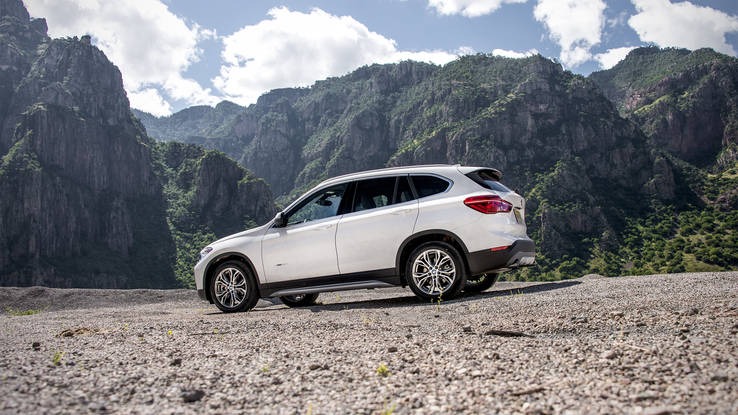
The 228-hp turbocharged inline-four is the sole powerplant this time around.
The new X1 is 0.9 inch wider, though its track gains 2.5 inches in width compared to the first-gen model. The 2016 X1 is also 2 inches taller, but less than an inch shorter in overall length, with BMW also adding a not-insignificant 1.5 inches to the height of the seats. BMW has also played with the wheelbase a bit, extending it and cutting the length of the overhangs to improve the handling. Through all these subtle revisions, the automaker has managed to squeeze out more cargo room and more legroom for the passengers, with the rear-seat passengers gaining even more legroom thanks to the optional sliding rear seats. Front-seat passengers, meanwhile, gain 1.5 inches of legroom. The gain in cargo space is a little more substantial on paper (and in person), with the new X1 gaining 3.0 cubic feet for a total of 21.7 with the rear seats in their upright and locked positions. Once the driver has turned off the seatbelt sign and the passengers can move about the cabin, they can fold down the seats to enjoy 58.7 cubic feet of cargo space, as well as make use of the storage bins.
BMW has done more than shift the chairs around — the X1 has gained ambient lighting on the dash and on the doors, in addition to offering five different leather colors. The dash has also been thoroughly redesigned, and houses the 6.5-inch iDrive screen.
The 2016 X1 goes on sale at the end of October, and starts at $ 35,795.
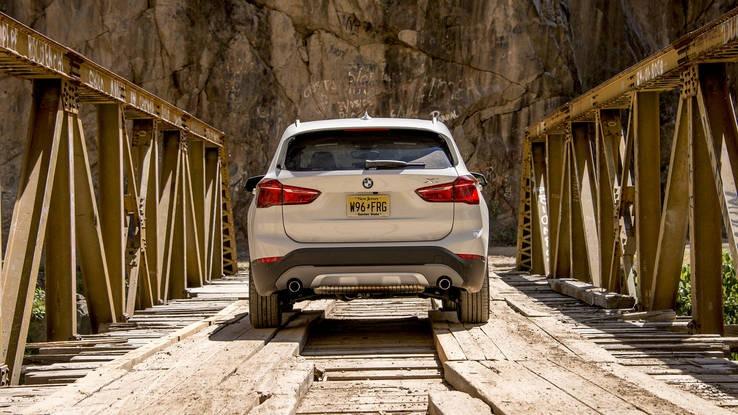
The 2016 model is taller, even though the overall length has shrunk by just a little bit.
What’s it like to drive?
BMW brought us to Mexico’s Copper Canyon to drive the X1 on some of the most exhilarating roads in the country. Located in Chihuahua state, the canyon is home to miles and miles of winding mountain roads, all of them remarkably well paved and rarely used.
But there are a couple of caveats to this automotive wonderland: every quarter-mile or so, there are rocks blocking at least one lane. Some are as big as the X1 itself, but there were also hundreds of little ones the size of baseballs (this is what runflat tires are for). There are just as many very liberally supervised free-range hoofed animals of unknown ownership — everything from burros to goats to bull calves (runflats aren’t much help here). In short, it’s a slightly surreal environment with some fairly real dangers — think “Sim City” crossed with “Mario Kart.” We saw a number of trucks that had definitely been pelted by a rock slide, with their body panels resembling the surface of a golf ball from dozens of stone impacts.
How did the new X1 tackle this obstacle course? Without breaking a sweat, which is more than we could say of ourselves after miles and miles of dodging scattered rocks hiding behind blind corners. The crossover’s brakes provide plenty of confidence during downhill descents at speed with the suspension keeping everything, including tire noise, in check when tackling hairpin turns, with the X1 staying well composed in the twisties.
On uphill sections, the engine doesn’t require high revs to climb back up. In fact, instead of jumping into the lower gears and revving itself silly, throttle response acts as if we were on even ground while climbing some serious grades. Through it all, the X1 held its own, seemingly unaware of the steep precipices and the terrain around it.

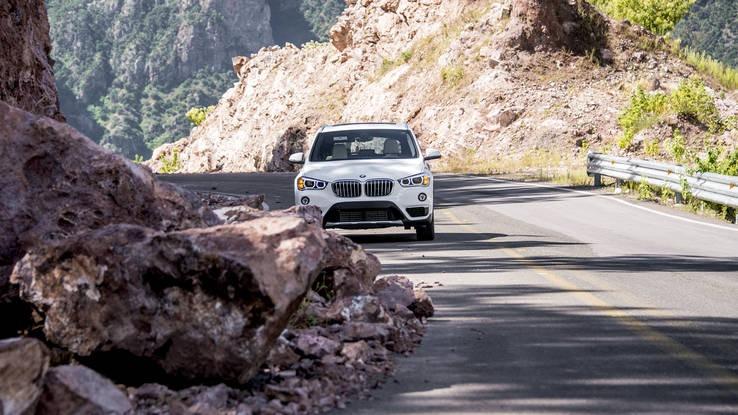
Note: Run-flats won’t make a difference with rocks this size.
We don’t usually see SUVs of this size and price category tackling terrain like this — mostly it’s armored Toyota Land Cruisers in UN livery — but the X1 maintains its civilized posture even over a varied but (mostly) safe menu of offroad terrain ranging from muddy puddles to sharp rocks.
On off-road sections at the bottom of the canyon, our United Nations White X1 (the official color name is alpine white) still offers good damping and predictable chassis response, keeping external annoyances out while Sirius XM murmurs something from the 1990s. Ground clearance being plenty for all but the sharpest boulders, which we steered around. The good turning radius of the X1 also comes into play when it came time for some close-quarters maneuvering, with the steering providing just the right amount of feel on and off the road.
The redesigned interior is a welcome change in the second-gen X1, with more expensive-feeling materials in the cabin and plenty of standard features. Everything is well laid-out and within easy reach — BMW does not always get this right — and the seating position is well-matched to outward visibility.
In short, the X1 is more than qualified to maneuver around a Whole Foods parking lot. And if that parking lot becomes partially blocked by a rock slide in some Michael Bay film scenario, the X1 will likely solve that with little effort.
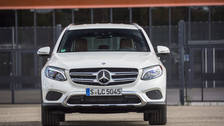
2016 Mercedes-Benz GLC300
What is it?The Mercedes-Benz GLC will soon be Mercedes’ best-selling SUV, and maybe even the best-selling Mercedes, period. OK. That assertion is ours, prognosticating, but it …
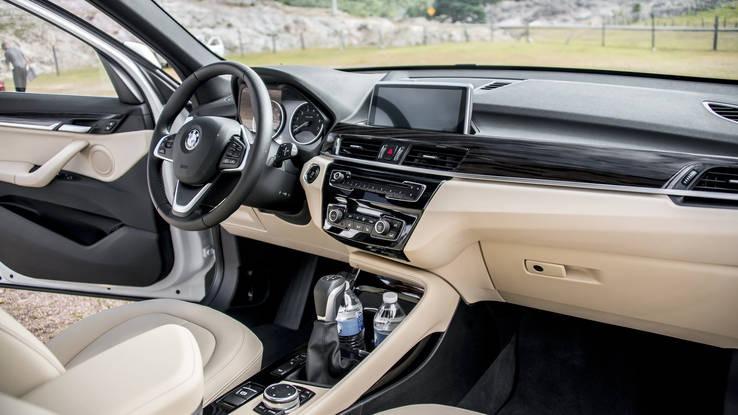
The X1 cabin is just the right size: not too big, and not too small.
Do I want it?
On their second attempt, BMW got the X1 right. The crossover’s predecessor was criticized for being feature-poor and expensive, requiring a used-Mini’s worth of options to be added just to get some basic creature comforts and gizmos. It also took some heat for being too close in size and features to the 3-Series station wagon while delivering a boring interior filled with gloomy plastics. Yet it still managed to win acclaim for being a fun machine with great handling.
BMW has evidently listened to both criticism and praise, and addressed each of the knocks point by point in a very methodical German fashion. The result is a refocused crossover that seeks to impress with standard features, and one that ultimately ends up being close in size and packaging to the X3 while making the Mercedes-Benz GLA-Class seem like a small hatchback in comparison.
Those who will be tempted to cross-shop the X1 with the GLA-Class will find the latter lacking in interior space — BMW is trying to deliver value here in the American way, by offering a greater amount of room. It’s best to think of the X1 as a GLC-Class and Audi Q3 competitor, and here it still manages to win with its well-sorted chassis, optimal ride height, and capable engine.
Priced to compete with midsize luxury sedans, the X1 will make plenty of sense to those who want opulence, versatility and the badge.






























